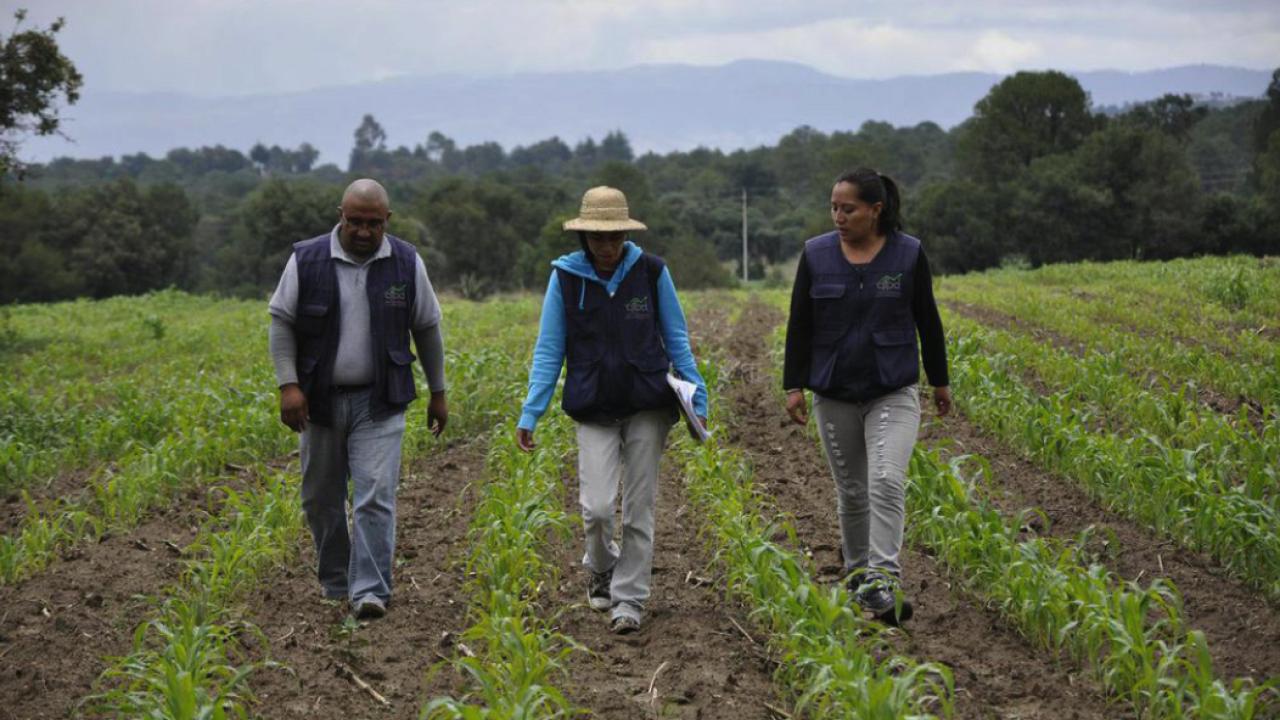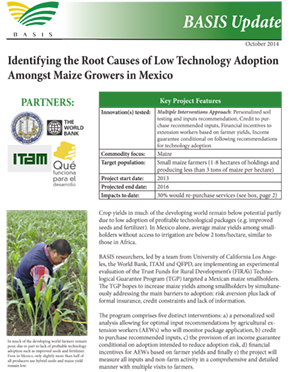
Crop yields in much of the developing world remain below potential partly due to low adoption of profitable technological packages (e.g. improved seeds and fertilizer). In Mexico alone, average maize yields among smallholders without access to irrigation are below 2 tons/hectare, similar to those in Africa.
Key Project Features
Innovation(s) tested: Multiple Interventions Approach: Personalized soil testing and inputs recommendation, Credit to purchase recommended inputs, Financial incentives to extension workers based on farmer yields, Income guarantee conditional on following recommendations for technology adoption
Commodity focus: Maize
Target population: Small maize farmers (1-8 hectares of holdings and producing less than 3 tons of maize per hectare)
Project start date: 2013
Projected end date: 2016
Impacts to date: 30% would re-purchase services
 BASIS researchers, led by a team from University of California, Los Angeles, the World Bank, ITAM and QFPD, are implementing an experimental evaluation of the Trust Funds for Rural Development’s (FIRA’s) Technological Guarantee Program (TGP) targeted a Mexican maize smallholders. The TGP hopes to increase maize yields among smallholders by simultaneously addressing the main barriers to adoption: risk aversion plus lack of formal insurance, credit constraints and lack of information.
BASIS researchers, led by a team from University of California, Los Angeles, the World Bank, ITAM and QFPD, are implementing an experimental evaluation of the Trust Funds for Rural Development’s (FIRA’s) Technological Guarantee Program (TGP) targeted a Mexican maize smallholders. The TGP hopes to increase maize yields among smallholders by simultaneously addressing the main barriers to adoption: risk aversion plus lack of formal insurance, credit constraints and lack of information.
The program comprises five distinct interventions: a) a personalized soil analysis allowing for optimal input recommendations by agricultural extension workers (AEWs) who will monitor package application, b) credit to purchase recommended inputs, c) the provision of an income guarantee conditional on adoption intended to reduce adoption risk, d) financial incentives for AEWs based on farmer yields and finally e) the project will measure all inputs and non-farm activity in a comprehensive and detailed manner with multiple visits to farmers.
TGP Impacts
The TGP caused an increase in maize yields of 1 ton per hectare perhaps due to the 36 percent higher probability of using improved seeds in the treatment group compared to the control group. Fertilizer usage, however, was unaffected by the intervention.
Although beneficiaries obtained larger yields, farmers in the control group earned larger profits. Revenues for beneficiaries increased by about 5,838 pesos per hectare, but the recommended credit package cost about 8,000 pesos more than the input package most commonly used in the region.
Thus, smaller credit offers for less costly input packages could increase both take up and profits. Farmers were also asked which components of the TGP program were most useful. Many farmers indicated that the personalized soil analysis and the frequent plot inspections by the AEW’s were the most useful features of the program. All in all, around 30 percent of beneficiaries reported that they would purchase these services in the future.
Key Lessons
Progress: Our pilot study in Tlaxcala state was small, with 75 and 78 farmers in the treatment and control arms respectively, because we learned that many farmers were not able to afford the input package and so could not participate in the program. Among study participants, only 18.4 percent had previously applied for credit, 41.5 percent had requested agricultural insurance and 22.4 percent had conducted any kind of soil analysis prior to the intervention. Regarding prior agricultural practices, 38 percent of producers had applied fertilizer at sowing and 14 percent had hired an agricultural extension worker in the past.
Challenges: Although the intervention had positive impacts on average, its implementation was not without problems. First, some inputs were distributed late among the beneficiaries as credit was disbursed around May when it should have been disbursed one month earlier, just prior to planting. Second, the program was poorly understood by some beneficiaries. For instance, the TGP included agricultural insurance that covered the production costs in case of a total or partial crop loss due to weather, but the farmers only reported 35 percent of the plots affected by adverse events to the insurance company.
Next Steps: The main lessons from this pilot are that (a) inputs must be delivered before sowing, (b) a different credit scheme should be offered that allows risk-averse farmers to request lower amounts instead of covering the total cost of input package and, (c) more effort should be devoted to informing farmers about the different program components.
This report is made possible by the generous support of the American people through the United States Agency for International Development (USAID). The contents are the responsibility of the Feed the Future Innovation Lab for Assets and Market Access at UC Davis and do not necessarily reflect the views of USAID or the United States Government.
